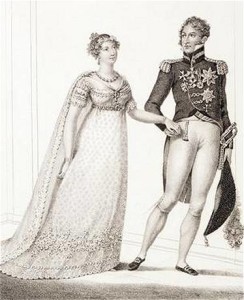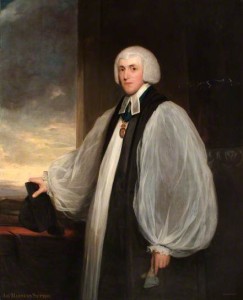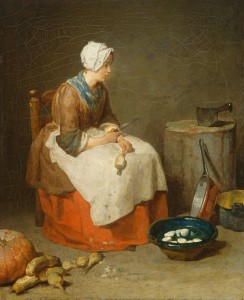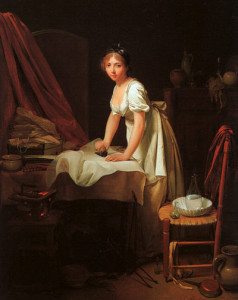The
Peace of Amiens seemed to be a peace no one really wanted to keep--it began on March 1802 and ended May 1803 when
Britain declared war again on France. Joseph Bonaparte, the First Consul's
brother, and Lord Charles Cornwallis, Marquis Cornwallis—the same Cornwallis
who had fought the Americans in their Revolutionary War—had signed the treaty after months of negotiations,
which had started the previous November, with a truce having been set in
October 1801.
The
treaty had no trade terms, the King of England gave up his hereditary claim to
the French throne, and France kept all conquests made since 1793, giving up only
its claims to the Papal States, Egypt, and the Kingdom of Naples. This left
French troops occupying North Italy, Germany, and the Netherlands. Bonaparte
also made no secret of his desire for France to continue expansion. However, in
the spring of 1802, many in England choose to see the one bright thing about
such a peace—it opened Paris to them again.
According
to The Age of Napoleon, by J. Christopher Herold, "By September
1802, there were about ten thousand Englishmen in Paris alone. The social scene
was more brilliant than it had been during the last years of the old regime. The
great salons, including the celebrated one of Madam Récamier, were open to the
more distinguished of the English visitors, and such new and dazzling places of
entertainment as the Tivoli and Frascati's were open to all who wanted to see
them."
At
about this time, Francis W. Blagdon made a bold trip to Paris, crossing as soon
as a truce had been announced and he could get a passport. His letters,
collected in Paris As it Was as it Is, provide a look at the city and
what he remembered of it from pre-Revolutionary days. He writes of Paris,
"What a charming abode is Paris, for a man who can afford to live at the
rate of a thousand or fifteen hundred pounds a year!" He exclaimed over
the beauty of the Tivoli gardens, and wrote, "...at Frascati, you
may, in that gay season, eat ices as good as those with which Cardinal de
Bernis used to regale his visitors...."

He
also notes, "The houses of the great are difficult of access, and
those of the secondary class scarcely open with more ease than they did before
the revolution. If proper attention be paid to all the letters which a stranger
brings, he may be satisfied; though the persons to whom he is recommended,
seldom think of taking him to the residence of any of their friends. Therefore,
an English traveler, who wishes to mix much in French society, should provide
himself with as many letters of recommendation as he can possibly obtain;
unless, indeed, he has a celebrated name...."
For
those who were happy with lesser amusements, the peace opened up the
opportunity to see the early "aeronauts." Andre-Jacques Garnerin, his
wife Jeanne-Genevieve, and his niece Elisa performed balloon ascents and
parachute descents in the Jardin de Tivoli.
But
quite the most popular attraction had to be Bonaparte, who had himself
proclaimed First Consul for life after coming to power and bringing under
control the worst of the Terror, and who held court at the Tuileries Palace.
"It was an impressive spectacle to see him in his gold-embroidered uniform
of state walk briskly through the two ranks of guests, stopping here and there
to ask a few brusque questions as if the visitors were so many generals,"
writes Herold.

Many
admired Bonaparte. While he had done away with the egalitarian
"Citizen" and "Citizeness" forms of address, he had also
stopped the Revolution's bloody madness, which had spiraled out of control,
taking the lives of aristocrats and revolutionaries. Bonaparte had begun public
works, including that of renewing construction of the Louver in 1803, which had
been opened by the Revolutionaries in 1793 as a public museum to display works
'liberated' from royal collections. His plans for Paris included new roads,
canals, buildings, and laws, such as the Civil Code or Code Napoleon. But while
Bonaparte brought structure, he also took away liberties. The press came under
his direct control, and his code took any many of the rights women had gained
under the Revolution. (It is said that he once told Madame de Stäle, "Women
should stick to knitting." Bonaparte believed a man should rule his home,
and that Bonaparte should rule France.)
Like
many liberal English Whigs, Charles Fox thought Bonaparte a man who could keep
the freedoms France had gained under her Revolution and still keep order. Fox
arrived in August 1802 with his wife to visit Lord and Lady Holland, who had
traveled abroad due to a doctor's recommendations for their eldest son's
health.
"The
Hollands had found many old friends upon their arrival in Paris. Lafayette,
Talleyrand, Madam de Flahault...Madame de Coigny, M. de Jaucourt, Gallois,
Morellet, Rumford, Calonne and Bertrand, were amongst the number," writes
the Earl of Ilchester in The Home of the
Hollands: 1605 - 1820. "They had seen the First Consul at a parade on
the day after their arrival, but only in the distance. Lady Holland then
likened him to 'Kemble in Miniature'." (That would be Kemble the actor—and
Bonaparte did love his theatrics.)
After
meeting Bonaparte, Lord Holland wrote of the man, "Bonaparte seems to
govern entirely by himself, and considers his Ministers and men of business
merely as clerks. He is undoubtedly
impatient of contradiction, to a degree amounting not only to a blemish in his
moral character, but to a weakness in his understanding. In every other
respect, however little one may approve, every one must admire him. The
Republicans who raised him, and the friends of rational liberty who first
produced and afterwards suffered by the Revolution, are clearly the two
descriptions of persons most dreaded and disliked by the Consul. He adopts the
principals of the old Government in many respects, but he certainly has the
advantage of not having his power necessarily connected with the restoration of
feudal laws and all the abuses which they had produced..."
Along
with new roads and buildings and its salons, Paris was a city of troops and
spies. Not everyone loved their First Consul. Bonaparte had already done away
with much of his competition for power in the late 1700’s. However, there had
been one plot in 1800 with an explosion set in the Rue St. Nicaise that had
failed to kill Bonaparte. Other plots continued. Royalists wanted to restore
the monarchy, republicans felt betrayed by Bonaparte's dictatorship and looked
for their chance to eliminate the man, jealous generals who had watched
Bonaparte's rise through the ranks sought their own opportunity to rule in his
stead, and other political factions wanted power as well. Bonaparte knew he had
enemies, and he intended to always be one step ahead of them, with his police
and those few advisors he trusted. He dealt with the extremists of the
Revolution, with uprisings in France, and with the royalist Chouans all with
the same brutal, quick military action to kill opposition. Literally.
In
Holland and the Netherlands, travelers saw the scars of war. In Paris, royal
palaces lay empty, stripped bare, or had been converted into hotels and
mansions for the new elite. Bonaparte restored the churches (which had been stripped
and converted into warehouses for the most part duing the Revolution).
The
Palais-Royal, built for Cardinal Richelieu and then made a palace for royalty,
had already been converted into a series of shops by Philippe, the Duc
d'Orléans. Gambling houses and brothels thrived here. The Place de Grève, next
to Paris's City hall, the Hôtel de Ville, was the traditional spot for
executions, and a guillotine continued in use here until 1830. But it was at the
Place de Concorde where the king and queen had lost their heads to Madame
Guillotine—it was said that at one time the stench of blood had been so strong
that cows refused to cross the square. Despite the French police, Paris had its
share of pickpocket's and thieves as well.
Still,
in 1803 (and echoed again in 1814) the mood of English visitors was to enjoy
the moment, not to find problems or bring up unpleasant history. Far better to
mingle in a fashionable Paris café with dashing French soldiers and charming
French women who still considered themselves liberated by the Revolution. Or to
bribe one's way into the First Consul's reception to glimpse the famous man and
his generals. Or to be daring and risk the latest discovery and current rage
and have one's child vaccinated.
Beyond
the social scene, the main attraction of Paris, for the English who had lived
under blockades and lack of trade goods for years, had to be the shopping.
Lord
Holland wrote, "The sums expended on dress are quite incredible, and the
richness of the shops in those articles, as well as in furniture, exceeds not
only all description we have ever heard in England but anything the most
expensive persons there can imagine."
In 1803, Bonaparte reestablished the Comédie Française, which had not existed since the Revolution (comedie
meaning dramatics, not comedy). The Académie des Beaux-Arts also began,
taking up the work of supporting the arts from the royal institutions that had
been abolished, the Académie Royale de Peinture et de Sculpture, the Académie
Royale d'Architecture, and the Académie Royale de Musique. Alexandre Grimod de
la Reynière published his work Almanach des Gourmands giving the world the idea
of food reviews. Paris had already invented the idea of what we would view as a
modern restaurant--a place designed to sell meals, as opposed to an inn that
provided meals to lodgers.
With
the Revolution, public eating areas or cafes flourish--what could be more
democratic, after all, than for the general public to enjoy the luxury of good
wine and good food. (It's reported that Bonaparte's soldiers would say,
"bistrot, bistrot" or "fast, fast," when eating in a
restaurant hence the name, bistro, and the start of fast foods.)
Beauvilliers,
at 1243 Rue de la Loi, had been famous for its food before the Revolution and
continued to serve, but now the new rich came with their demi-monde ladies. Blagdon
noted that the restaurant offered, "Soups, thirteen sorts.—Hors-d'œuvres,
twenty-two species.—Beef, dressed in eleven different ways.—Pastry, containing
fish, flesh and fowl, in eleven shapes. Poultry and game, under thirty-two
various forms.—Veal, amplified into twenty-two distinct articles.—Mutton,
confined to seventeen only.—Fish, twenty-three varieties.—Roast meat, game, and
poultry, of fifteen kinds.—Entremets, or side-dishes, to the number of
forty-one articles.—Desert, thirty-nine.—Wines, including those of the liqueur
kind, of fifty-two denominations, besides ale and porter.—Liqueurs, twelve
species, together with coffee and ices."
Dancing
continued as a rage in Paris. In the opera, Bladgon notes that audiences showed
a mania for pirouettes, and writes,
"The most famous pantomimical ballets or ballets d'action (as they are
styled) now represented here, are Psyché, Télémaque, Le Jugement de Paris,
Mirza, and la Dansomanie." And for dancing at balls he writes, "The
French country-dances (or cotillions, as we term them in England) and waltzes,
which are as much in vogue here as in Germany, were regularly
interchanged."
But
the peace did not last.
Despite protests from Lord Whitworth, the English
Ambassador, about provocations, Bonaparte violated the treaty. He reacted badly
to criticisms from King George, restricted the sale of English newspapers in
France when they spoke against his actions, and banished Madame de Stale, who
spoke out for Revolutionary ideals of justice and freedom, so that she must
stay forty leagues outside of Paris. Finally, he broke the treaty with and
issued an order for the arrest of all English—men, women and children. In
addition to taking any English prisoners, Bonaparte gave orders to occupy
Hanover--a move designed to insult since King George's family held the
hereditary office Electorate of Hanover. Bonaparte also moved to reoccupy
Naples.
In
a letter, Bonaparte wrote, "If the English want
to make us jump the ditch, we will jump. They may capture a few frigates or a
few colonies, but I will strike terror in London, and I prophesy that before
the war is over they will weep tears of blood." His prophesy was not
entirely correct.
By July the Louisiana Purchase had been announced in the United
States. Bonaparte was starting to have seller's remorse, and so Jefferson did
not wait for Congress to ratify the treaty but moved ahead with plans for an expedition.
But Bonaparte had other things to occupy him, such as plans to invade England.
Traveling to the French coast, Bonaparte inspected the port cities
and decided on Boulogne as his crossing. He believed, "With a good wind we
need the fleet for only twelve hours." This was his first major military
blunder. The English Channel would never give him that good wind, and the
British navy would bottle up half his fleet in one port and sink the rest of
it during he next two years. All the gains Bonaparte had made--and could have kept if that peace had held--were to be lost to France.



















